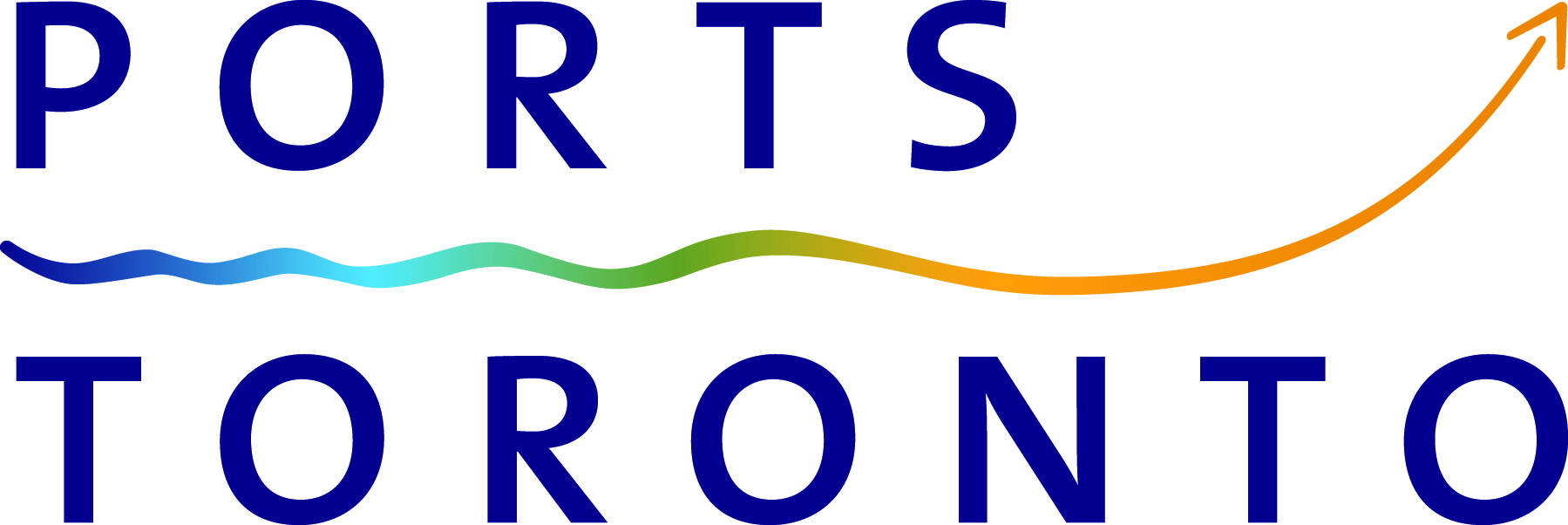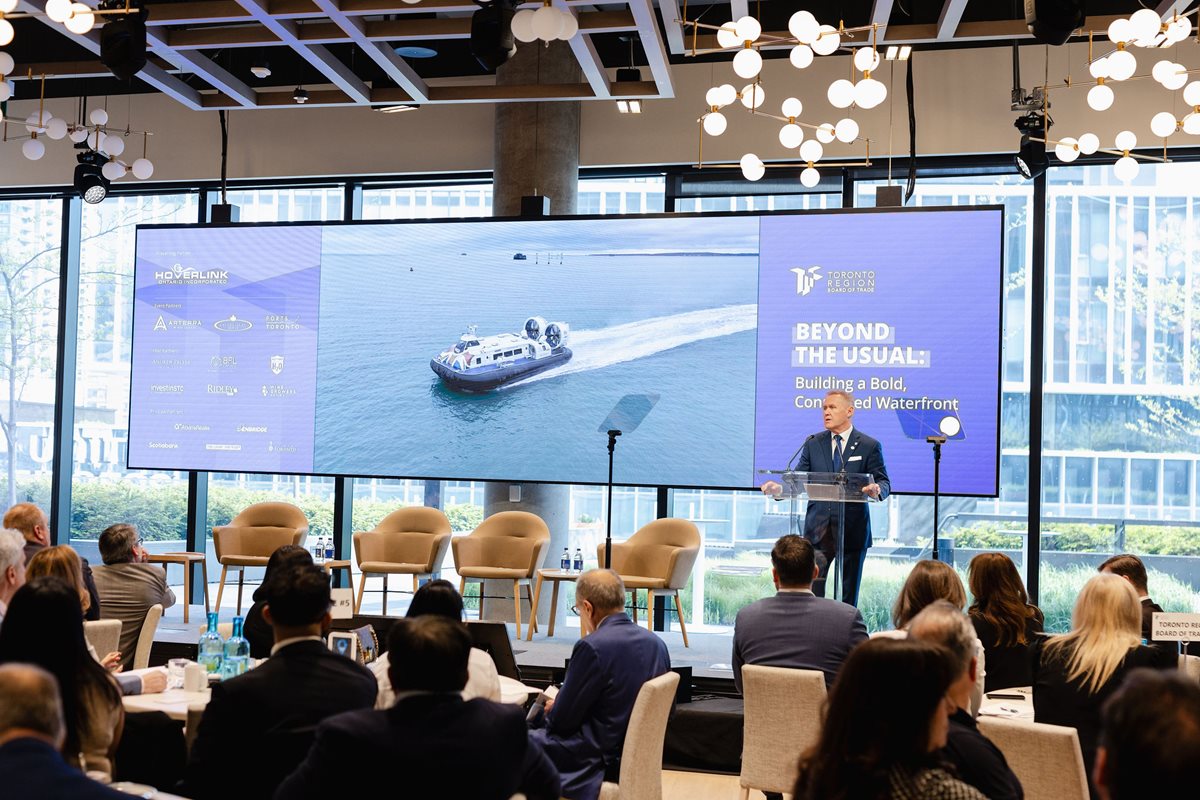
For decades, Toronto has faced the lake, but turned its back on what the waterfront could be. Despite world-class institutions, a thriving visitor economy, and a dense, rapidly growing downtown core, our waterfront remains disconnected. At our Beyond the Usual: Building a Bold, Connected Waterfront event, we imagined a future where the waterfront moves people, goods, and culture, not just along the shore, but across Lake Ontario itself.
The Board convened civic leaders, planners, transit experts, and innovators to spotlight Hoverlink Ontario’s plans to build a high-speed hovercraft service connecting Toronto and the Niagara Region. With a site now secured to dock Hoverlink’s craft near Billy Bishop Airport, the dream is closer than ever to reality.
Propelled by Hoverlink’s proposal, the discussion turned to ideas about how to reclaim our waterfront as an economic engine and unlock new modes of regional mobility to tackle the congestion crisis that’s holding our entire region back.
From exploring multimodal integration to rethinking the last mile, speakers brought forward real solutions, like the opportunity for waterborne transit to ease inner-harbour gridlock. Hoverlink’s proposal became a springboard for the chance to build a waterfront city, not just a city with a waterfront.
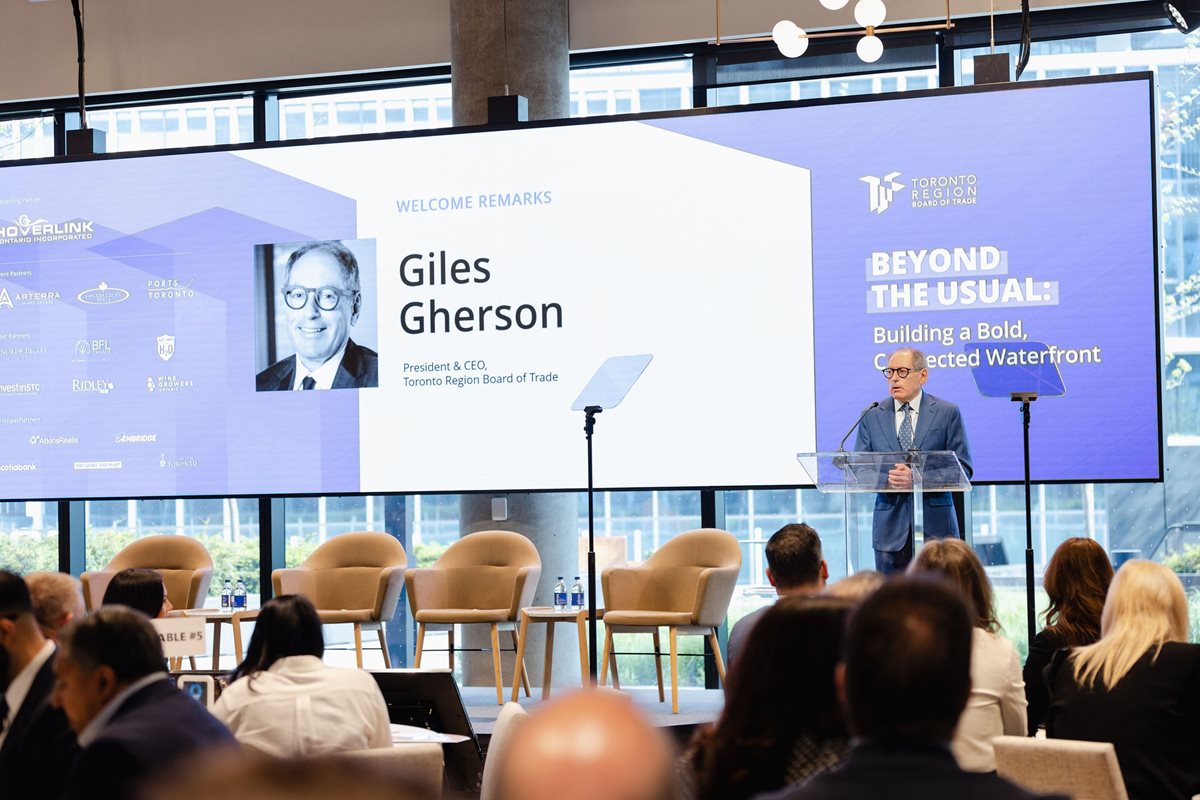
The Waterfront Is Toronto’s Next Growth Engine
Toronto has long talked about its waterfront as a place, now it must be seen as strategy. A connected waterfront isn’t just about moving people, it’s about unlocking economic value: expanding housing options, driving tourism, and enabling labour mobility across the region. What was once a missed opportunity can become the city’s next competitive edge.
Big Ideas Require Unified Leadership
Toronto’s waterfront isn’t defined by one project—it’s the sum of many. And if they don’t add up to something greater, we fall short. Success depends on coordinated leadership across governments, agencies, and the private sector. It’s time for a “Team Waterfront” approach, one vision, many builders.
Marine Mobility Must Be Part of Our Congestion Solution
City-building has typically bypassed the lake as a transit corridor, but that’s changing. Hoverlink’s high-speed service presents a new multimodal system—where ferries, streetcars, LRT, and rapid rail are all part of one cohesive vision. A region as dynamic as ours demands more than just road and rail. We’re currently losing $45 billion annually to congestion, and that’s not a traffic issue - it’s a growth crisis.
Mobility Shapes How We Live
Solutions like Hoverlink offer more than convenience. By removing 8,000 cars a day from the QEW, they promise shorter commutes, and better productivity. When transit is joyful, everything changes. Whether it’s commuting to work or returning from a midweek show in Niagara, transportation that is fast, reliable, and inspiring elevates quality of life. When people are free to move easily and sustainably, they’re free to focus on what matters most.
30 minutes
Proposed crossing time from downtown Toronto to the Niagara Region via Hoverlink.
8,000 vehicles
Estimated number of cars that could be taken off the QEW each day.
180 passengers
Capacity per hovercraft, operating year-round over water, ice, and land.
48 crossings per day
Planned number of daily hovercraft trips between Toronto and Niagara.
60 decibels
Noise level of Hoverlink hovercrafts at 500 meters offshore, comparable to normal conversation.
“We often talk about congestion on roads, but what about the highway on the water? The lake is our Highway If we treat it as infrastructure, not just scenery, we unlock a whole new way of moving people and goods into the heart of Toronto.”
— Jim Athanasiou, President & CEO, St. Lawrence Seaway Management Corporation
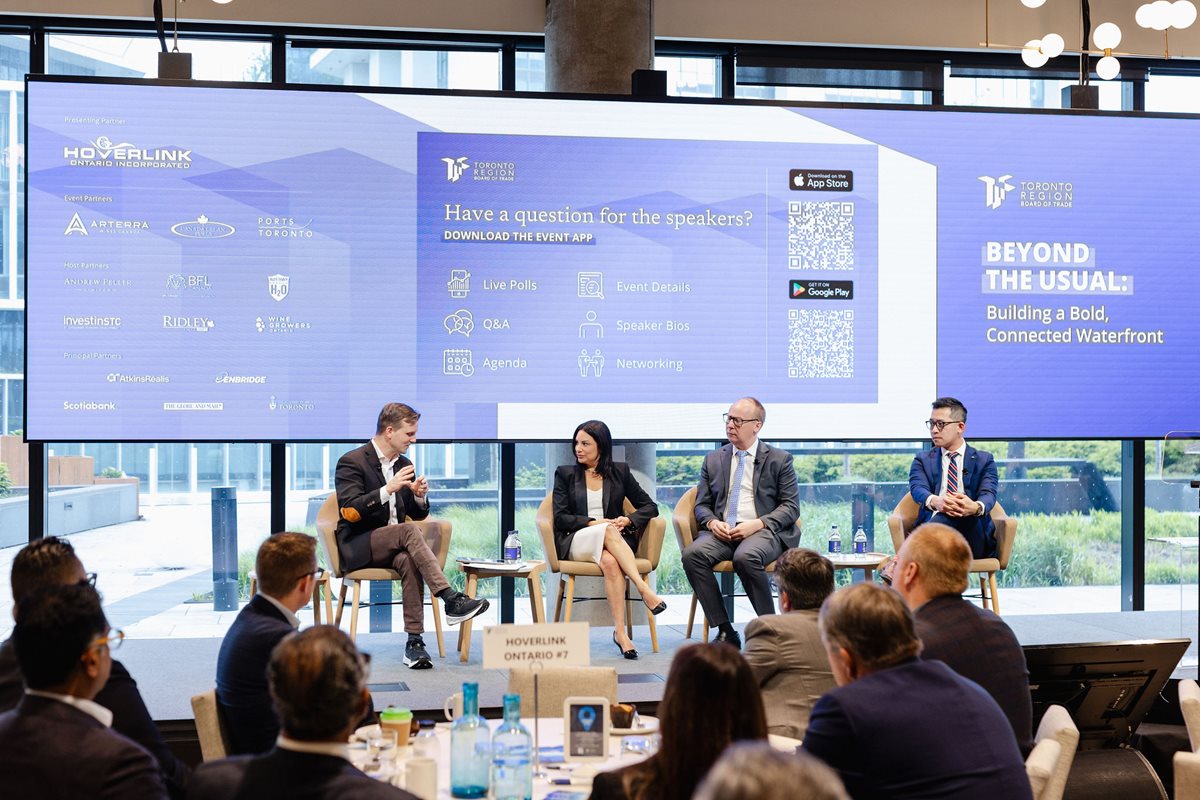
"You have to build the city you want before you build it. We’ve got the vision — a dynamic, connected waterfront — but now we need to act. This isn’t about blue-sky dreaming anymore. It’s about delivering on the future we already know we need."
— Joe Cressy, Chief of Staff, Waterfront Toronto
“Hoverlink is a project positioned to bring people between Toronto and Niagara—on hovercrafts carrying many passengers sustainably, including bikes and luggage. It’s meant to increase the level of tourism we see between the two regions through an attraction. Marine transit isn’t new across Canada, but it is in Ontario.”
— Erika Potrz, Interim COO & President, Hoverlink Ontario Inc.
“The last thing we would want is for a literal boatload of people to arrive into Toronto and then choose other means of transportation, whether it’s a rideshare or something else that ends up adding back to the congestion in city streets. We want them to think of public transit as the logical transfer for them to make when they get to Toronto.”
— Eric Chu, Head, Transportation Planning & Engineering, Toronto Transit Commission
“The Board is pulling together all the right people to make the waterfront work, not just for transit, but for tourism, commerce, and community. Imagine being able to cross the lake after a show at the Shaw Festival and still get home midweek. That’s the kind of shift we’re talking about.”
— Tim Kocur, Executive Director, Waterfront BIA
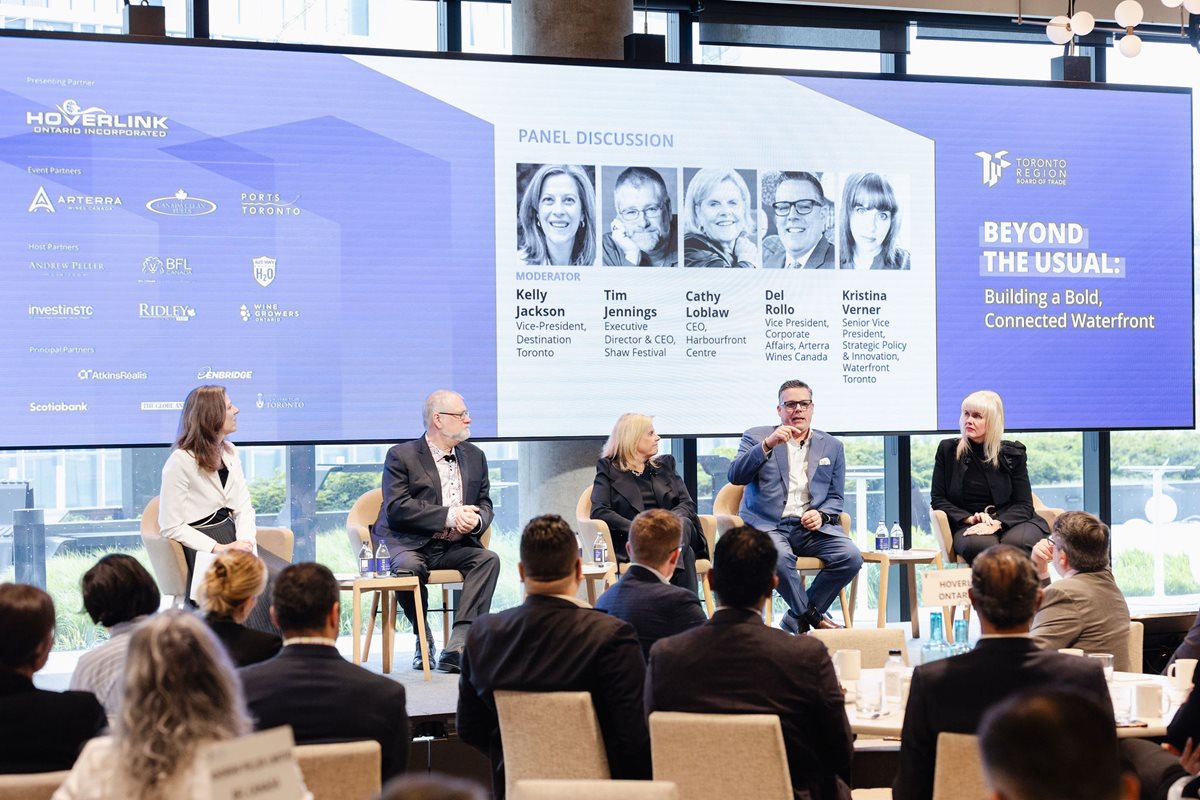
“You have this incredible opportunity with Hoverlink to change what’s possible. People can now come to the Shaw Festival from Toronto mid-week—after work even—and be home that night. That’s a game changer for us. We think about the opportunity this creates for both sides of the lake. Tourism isn’t just about overnight stays. It’s about access, and this opens up a whole new way to experience culture across the region.”
— Tim Jennings, Executive Director & CEO, Shaw Festival
“We need government leaning in, and we need private enterprise stepping up. It’s going to take hovercrafts, ferries, sea buses, you name it to build the kind of waterfront experience we’re talking about. And let’s not forget, happy commuters are happy people. It shouldn’t take so much effort to arrive and feel calm, cool, and collected.”
— Del Rollo, Vice President, Corporate Affairs, Arterra Wines Canada
“A more connected waterfront is a more accessible waterfront. The better we make it to get here, the more we unlock our city’s cultural, social, and economic potential. This isn’t just about commuting. It’s about belonging.”
— Cathy Loblaw, CEO, Harbourfront Centre
Thank you to our partners:



